Xiaomi and Huawei collision incident: AEB is not a panacea for safety
![]() 04/16 2025
04/16 2025
![]() 739
739
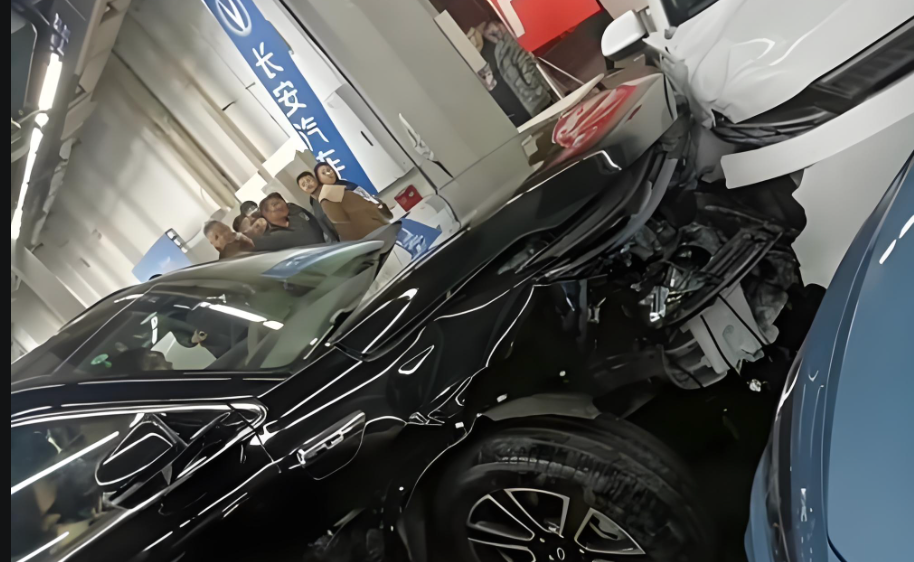
Author | Zhang Lianyi
Following Xiaomi, Huawei has also had an incident.
On the afternoon of April 13, an AITO M7 Pro was involved in a collision incident at the Industrial Exhibition Hall in Shenyang, Liaoning, resulting in injuries to one person.
In response, AITO stated that preliminary investigations showed that the accident occurred on the eve of the auto show withdrawal, and the vehicle was not in exhibition mode, leading to it being accidentally started. Since the driver did not fasten their seat belt and made large steering wheel interventions, the conditions for AEB activation were not met.
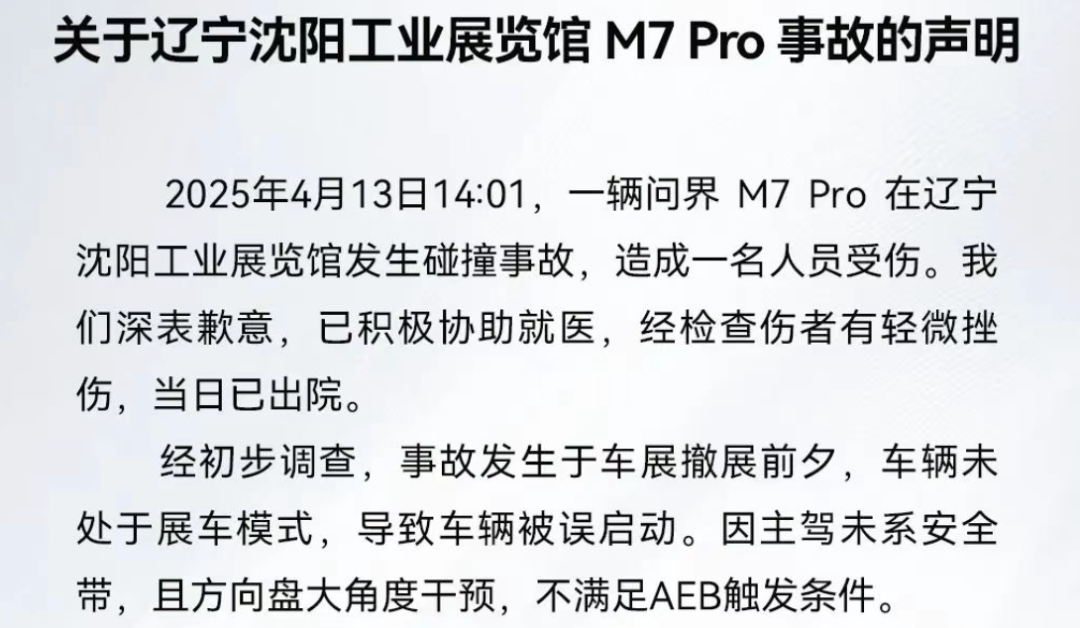
AITO's response to the incident
However, previously, both Yu Chengdong, Chairman of Huawei's Consumer BG, and Jin Yuzhi, CEO of Huawei's Intelligent Automotive Solutions BU, have repeatedly hyped the power of AEB (Autonomous Emergency Braking) without mentioning its flaws.
The reality is that regardless of the company, the AEB system, promoted as a "life-saving device," is not omnipotent. It is like a car's airbag but cannot replace a seat belt.
As the wave of autonomous driving continues to advance, it should also be noted that individual technologies should not be overly deified. After all, the most reliable "active safety system" is always the vigilant human brain in the driver's seat.
01
AEB has many blind spots
Intelligent driving has always been a point of pride for Huawei.
Last April, ahead of the Beijing Auto Show, Huawei mentioned during the launch of ADS 3.0 that it took active safety one step further. In scenarios where the AEB braking distance is insufficient, the system automatically performs emergency steering to avoid obstacles without requiring the driver to first turn the steering wheel. Lateral active safety also supports more scenarios, such as supporting vehicles, bicycles, and electric bikes that are crossing diagonally or horizontally, and more flexible avoidance spaces.
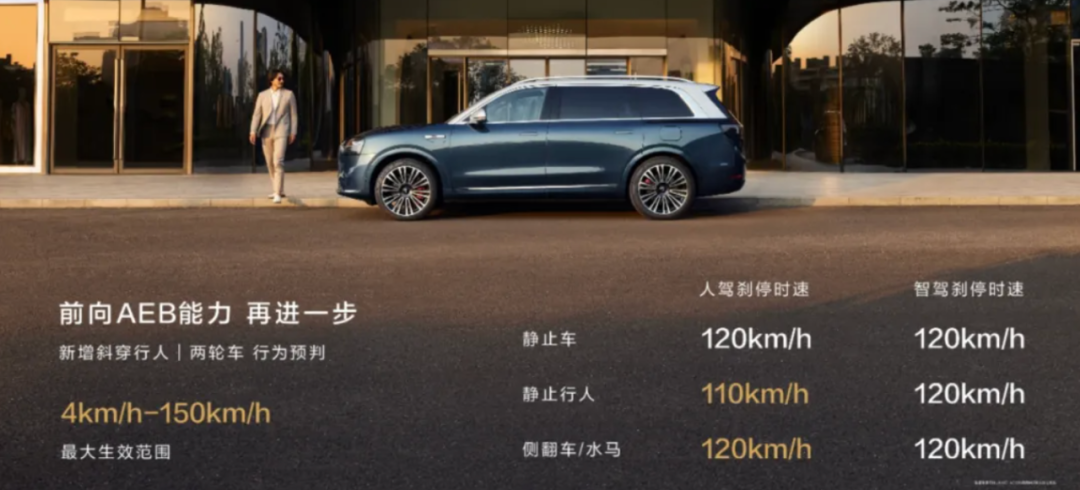
Yu Chengdong said the AEB capability of the AITO M9 large five-seater model has been enhanced
In September of the same year, at the launch event for the AITO M9 large five-seater model, Yu Chengdong stated that the forward AEB capability had been enhanced, supporting anticipation of pedestrians and two-wheelers crossing diagonally, with a maximum effective range of 4-150km/h. With the coordination of intelligent and human driving, the stopping speed can be increased to 120km/h, and in stationary pedestrian scenarios, the stopping speed for human driving can reach 110km/h.
But what they didn't say was that in the vehicle function design of HarmonyOS Intelligent Drive, AEB will not activate if the seat belt is not fastened. This is because emergency hard braking might throw occupants out of their seats. Additionally, large steering wheel movements will not trigger AEB because the tire grip decreases during large steering movements, and emergency hard braking might cause the vehicle to roll over.
Of course, this is also the choice made by most automakers.
Just half a month ago, on the late night of March 29, Xiaomi also experienced a similar AEB controversy.
In that incident, many people questioned, "Why didn't the AEB function activate when the vehicle was so close to the cones?"
Xiaomi responded to this question in a Q&A format.
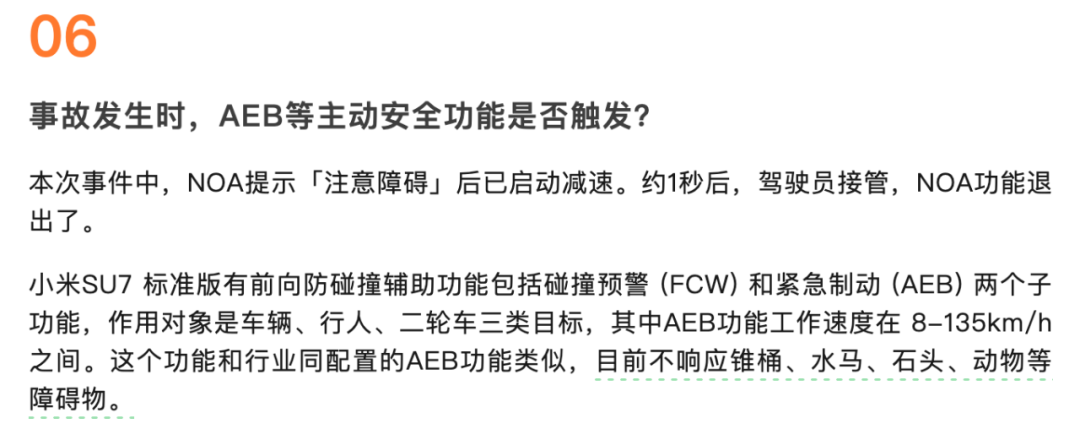
Xiaomi's response on whether AEB activates
It stated that in this incident, the NOA system prompted "Caution: Obstacle" and initiated deceleration. About one second later, the driver took over, and the NOA function was disengaged.
The Xiaomi SU7 Standard Edition has a forward collision avoidance assistance function, including two sub-functions: Collision Warning (FCW) and Emergency Braking (AEB), targeting vehicles, pedestrians, and two-wheelers. The AEB function operates within a speed range of 8-135km/h. This function is similar to AEB functions with the same configuration in the industry and currently does not respond to obstacles such as cones, water barriers, stones, animals, etc.
It is confirmed from Xiaomi's response that the AEB function of the accident vehicle was not triggered.
This is also the first time it has clearly stated that the AEB function currently does not respond to obstacles such as cones, water barriers, stones, animals, etc.
In the past, Xiaomi founder Lei Jun introduced the AEB at the SU7 launch event, stating that the automatic emergency braking function successfully identified and immediately stopped for a stationary disabled vehicle in the front lane at speeds of up to 135km/h during the day and 120km/h at night.
Obviously, when promoting AEB as a "safety" feature, automakers often avoid discussing its existing technological bottlenecks.
02
It enhances driving safety to a certain extent
Before discussing the bottlenecks, let's first discuss what AEB is and whether it is useful.
AEB stands for Autonomous Emergency Braking.
The rapid development of Advanced Driver Assistance Systems (ADAS) has brought multiple active safety technologies, with AEB being a crucial one.
It consists of perception, decision-making, and execution layers and is an assisted driving algorithm. Its basic principle is to use sensors such as millimeter-wave radars, cameras, and lidars to perceive information around the vehicle and transmit the collected information to the control module, which judges the danger of the vehicle based on the information and vehicle status.
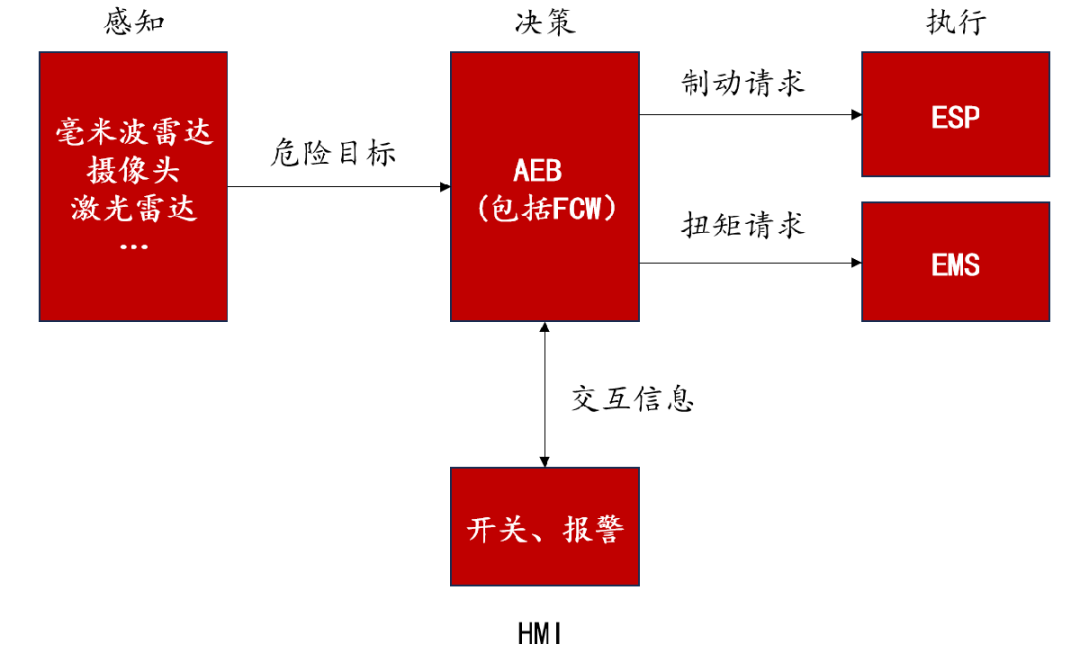
AEB technical logic. Source: Qi Wei, "Analysis of AEB Automatic Emergency Braking System"
When the vehicle is judged to be at risk of collision, the system will warn the driver. If the driver does not make an avoidance action in time, the AEB system will actively intervene in the braking system to slow down or stop the vehicle.
As early as 2002 and 2003, automakers such as Mercedes-Benz, Honda, and Toyota had already begun attempting to implement AEB functions. Currently, AEB has become one of the most basic and core functions in the ADAS function system and is considered by consumers as a line of defense for active safety.
AEB includes two subsystems: Collision Imminent Braking (CIB) and Dynamic Brake Support (DBS). The CIB system performs emergency braking on the vehicle in the event of a rear-end collision and when the driver takes no action. The DBS actively increases braking force to avoid collisions when the driver does not apply sufficient braking force.
Its crucial parameter is Time to Collision (TTC), which is the time calculated by the moving vehicle for a possible collision with the object ahead, defined as the distance between the vehicle and the obstacle divided by the relative speed. The core logic of AEB system collision avoidance is to determine the appropriate intervention time. When TTC is small enough, the AEB system takes braking measures.
When the AEB system is activated, it mainly follows two principles: one is not to affect the user experience, i.e., the system should not activate prematurely when the driver has time to react; the other is to ensure braking effectiveness, i.e., the braking time should be earlier than the latest braking time for the braking system to stop the vehicle, thereby achieving the purpose of collision avoidance.
Theoretically, AEB can effectively reduce the occurrence of safety accidents.
According to data from the National Highway Traffic Safety Administration (NHTSA), the primary cause of over 90% of severe car accidents is driver error.

Euro NCAP believes AEB can improve vehicle safety
According to research data from Euro NCAP, vehicles equipped with AEB can reduce rear-end collisions by 38%, fatal crashes by 20-25%, and the likelihood of injury by 25-30%.
This means that the AEB function plays a certain role in driving safety and will become increasingly important as the function improves.
03
AEB has four "fatal flaws"
However, AEB is obviously not a panacea and does not work in all situations, and it may even cause some new problems.
First, there are scenario limitations, with a sudden drop in recognition rates for crossing vehicles and oddly shaped vehicles (such as construction vehicles).
In the initial simple AEB solutions, the main obstacles calibrated by the system were vehicles and pedestrians. Children, pets, traffic cones, and some oddly shaped detection objects could not be recognized. However, with the maturity of sensor products and the continuous addition of sensor hardware, the shortcomings of perception capabilities have been gradually compensated for, but there are still corner cases in the richness of perception scenario calibration and algorithm training.
This leads to limitations in the recognition of crossing vehicles and oddly shaped vehicles by the AEB system. At the same time, there are certain issues with recognition in poor weather and lighting conditions, low-speed and high-speed scenarios, and static target recognition.
Second, there is the risk of false triggering, with tunnel shadows potentially causing phantom braking.
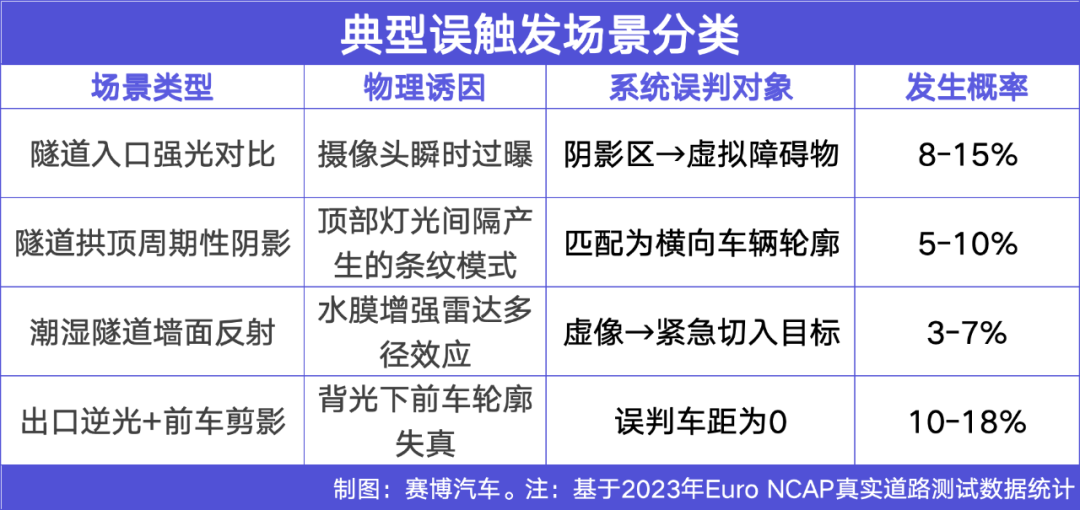
The fundamental reason for false triggering of the AEB system lies in its technical limitations and algorithm flaws. The AEB system relies on sensors (such as cameras and radars) to perceive the front environment, but the accuracy of sensors can drop significantly under changing light conditions, inclement weather, or complex road conditions. Meanwhile, multi-sensor fusion algorithms also have deficiencies. Errors may occur in data synchronization and fusion algorithms from different sensors, leading the system to misjudge the presence of obstacles ahead.
The dangers include increased risk of rear-end collisions (especially on highways), potential neck injuries to passengers due to sudden braking, and a crisis of trust in the driver assistance system among drivers.
Tesla has recalled vehicles multiple times due to false AEB triggering issues.
Third, there is a "delay" in the AEB braking link.
From the appearance of a target to full braking, the AEB system goes through five essential stages that cannot be compressed, with each stage consuming valuable time. At least 0.3-0.5 seconds are required on sunny days, which may extend to 0.8 seconds on rainy days. Drivers need to pay constant attention. Although this delay is acceptable under normal conditions, the extended response time in inclement conditions such as rain may reduce system reliability.
Fourth, there is a dilemma of responsibility, as system intervention may lead to secondary accidents, raising questions about how to apportion liability.
In 2022, a vehicle equipped with Bosch's third-generation AEB system was driving on a German highway when the system falsely identified a cardboard box falling from a truck ahead as an obstacle and suddenly applied emergency braking. The truck behind it crashed into it due to following too closely, causing a three-car pileup and minor injuries to two people.
This led to a dispute over liability, with the car owner accusing the AEB system of "overreacting" and the truck driver claiming that the "sudden braking of the front vehicle for no reason" should bear full responsibility. Bosch defended itself by stating that it "complied with the ISO 22179 standard".
Ultimately, the court ruled that the automaker was 30% responsible, as the AEB algorithm did not fully assess the risk of false braking; the truck behind was 70% responsible for not maintaining a safe distance (the legal minimum distance in Germany is 2 seconds); and Bosch was exempted from liability as the system met the "reasonable expectations" standard.
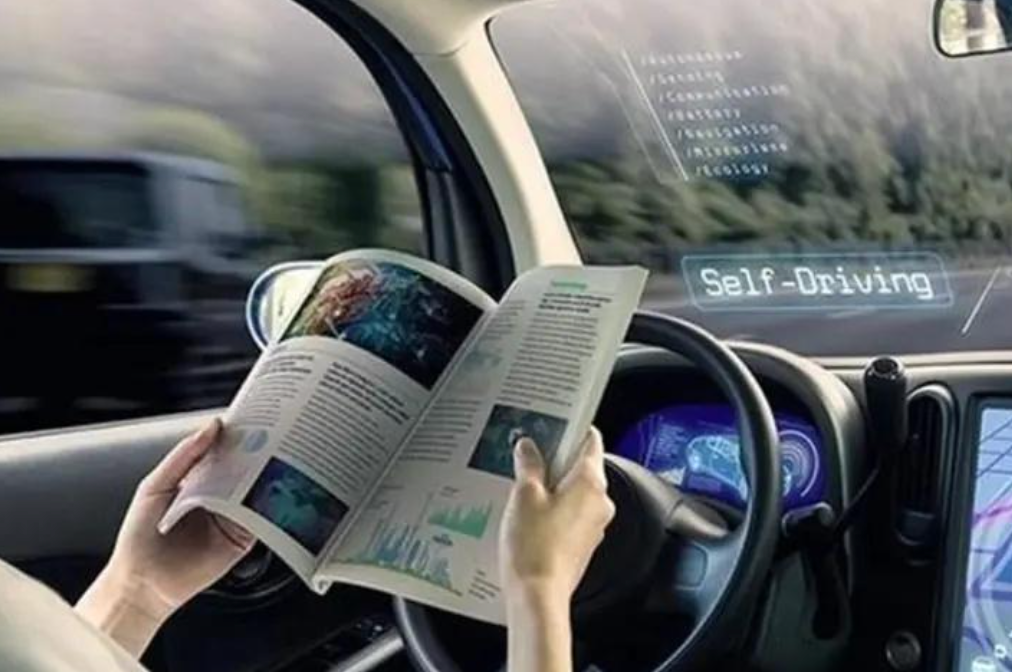
Although Germany's "Ethical Guidelines for Automated and Connected Vehicles" clearly states that autonomous driving systems should prioritize human safety in the event of an accident and prohibit selective sacrifices based on personal characteristics, in practical operations, balancing technological limitations and ethical principles remains an urgent issue to be resolved.
Overall, AEB is obviously not a "universal talisman," and its physical sensors have insurmountable detection limits. In the foreseeable future, drivers' active anticipation of special scenarios will remain an irreplaceable safety line of defense. As automakers, promoting only the strengths while avoiding the weaknesses is also an irresponsible behavior. As drivers, remember that when you encounter inclement weather or environments on the road, or see yellow construction vehicles, etc., assume that AEB does not exist. This is also the wisdom for survival in the intelligent era.







